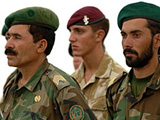Costs of War: Hotel Afghanistan
By Shaun Waterman for ISN
This month, the US Department of Defense launched what critics might call an information operations offensive on the topic of the work the US-led NATO coalition is doing training and equipping the Afghan military and national police.
Lieutenant General William B Caldwell, the officer in charge of both US and NATO training and security transition, briefed the Pentagon press corps via external pagelive videocall_made, and he and several subordinates took part in media conference calls.
The context is clear: for a variety of reasons, both policy and political, the Obama administration wants to make the start-date of its planned transition to Afghan security control as credible as possible.
And that means creating - or at least creating the perception of - credible Afghan security forces.
“Our mission is critical to ISAF's overall strategy of transition of security to the Afghan government,” Caldwell said. “In many ways, you can say that the Afghan National Security Force is transition.”
Caldwell, while lauding progress the US-led coalition had made - he noted that the army and police had grown faster in the first six months of 2010 than at any other point in their history - did not minimize the problems he faced.
He described how illiterate soldiers had complained about not being paid, because they could not access the funds in the bank accounts set up for them to receive their pay and eliminate the potential for corruption inherent in a system of cash payments.
Mandatory literacy training is one of the changes Caldwell has introduced.
There are currently 134,000 soldiers in the Afghan National Army, and 109,000 in the Afghan National Police, meaning Caldwell’s command needs to recruit an additional 56,000 to meet the transition goal of 305,000 personnel by October 2011.
But Caldwell estimated that to meet that goal - given the high attrition rates for recruits - he will have to recruit and train 141,000 Afghans in the next 15 months, a huge task.
“Losses from attrition … include desertions, deaths and low retention. They pose the greatest threat to both quantity and, for us, quality of the security force,” he said.
Down in the weeds, his subordinates were even more frank. Italian Brigadier General Carmelo Burgio, in charge of NATO’s police training mission, reminded reporters what part of that attrition rate was about. “For every Afghan national army soldier killed, we have three or four policemen killed,” he told a Pentagon external pagepress callcall_made.
He also lauded the much-criticized decision by Afghan President Hamid Karzai to ban private security contractors and insist all such work be done by government forces.
“The presence of the private security companies … who provide better salary” was an “issue” for retention, he said. Karzai’s decision, he hoped “could slow down the attrition.”
Burgio was also frank about the scale of the training challenge, noting that, in addition to rooting out would-be infiltrators, the NATO training programs drug-tested all their recruits and had recently broken up a drug trafficking organization inside a training center.
But it was on the issue of the fight against corruption that Burgio, who has experience fighting organized crime in Italy, really got off message, happily ignoring any transition deadlines. “We need generations to solve the corruption problem,” he said, comparing it to the fight against organized crime. “Each generation lasts 20, 25 years. To solve the corruption problem, we need two or three generations.”
Small wonder then, perhaps, that a senior Obama administration official told the external pageNew York Timescall_made that “fighting corruption is the very definition of mission creep.”
Recent revelations that the CIA has large numbers of the Afghan president’s staff on their payroll may not have come as a shock to anyone who closely follows the region, but they do highlight a contradiction in US policy: Is Afghanistan an ally or a client?
The same contradiction illuminates comments by Karzai’s chief of staff Mohammad Umer Daudzai in a rare interview with the external pageWashington Postcall_made.
The paper reported he told US Afghan commander General David Petraeus that “winning the hearts and minds of the Afghans is not the job of a [US] soldier. That's the job of an Afghan."
"We need to review our strategy, our code of conduct, so that Afghans believe that this is a sovereign state and President Karzai is the ultimate decision maker in this country,” he said.
For a long time, US policy can be viewed as having treated the Karzai government more like a client than an ally. Now that the US has started to publically think about its exit strategy, would it be strange if Afghan officials started to question its motives more aggressively?
The generational commitment that General Burgio quite rightly identified as being required to root out corruption is way beyond what an embattled Obama administration wants to consider. But the alternative could be more unpalatable still.

